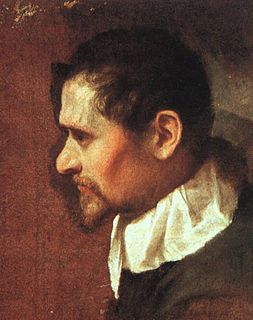
Annibale Carracci was an Italian painter and instructor, active in Bologna and later in Rome. Along with his brother and cousin, Annibale was one of the progenitors, if not founders of a leading strand of the Baroque style, borrowing from styles from both north and south of their native city, and aspiring for a return to classical monumentality, but adding a more vital dynamism. Painters working under Annibale at the gallery of the Palazzo Farnese would be highly influential in Roman painting for decades.
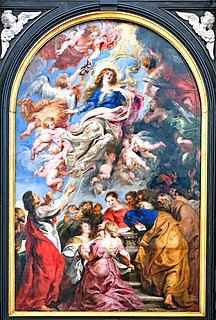
The Assumption of the Virgin Mary or Assumption of the Holy Virgin, is a painting by Peter Paul Rubens, completed in 1626 as an altarpiece for the high altar of the Cathedral of Our Lady, Antwerp, where it remains.
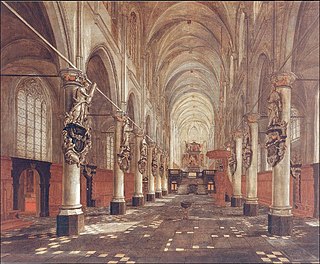
The Elevation of the Cross is the name of two paintings, a very large triptych in oil on panel and a much smaller oil on paper painting. Both pieces were painted by the Flemish artist Peter Paul Rubens in Antwerp, Belgium, the original in 1610 and the latter in 1638.
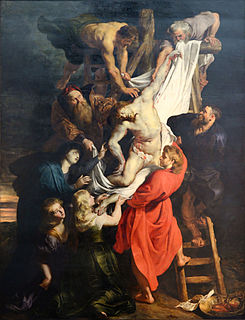
The Descent from the Cross is the central panel of a triptych painting by Peter Paul Rubens in 1612–1614. It is still in its original place, the Cathedral of Our Lady, Antwerp, Belgium, along with another great altarpiece The Elevation of the Cross. The subject was one Rubens returned to again and again in his career. This particular work was commissioned on September 7, 1611, by the Confraternity of the Arquebusiers, whose Patron Saint was St. Christopher.
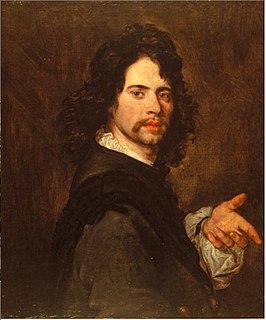
Jan van den Hoecke was a Flemish painter, draughtsman and designer of wall tapestries. He was one of the principal assistants in Rubens' studio in the 1630s. He later traveled to Italy where he resided for a decade in Rome. He subsequently worked as a court painter in Vienna and Brussels. Jan van den Hoecke was a versatile artist who created portraits as well as history and allegorical paintings.

Artus Wolffort, Artus Wolffaert or Artus Wolffaerts (1581–1641) was a Flemish painter known mainly for his history paintings depicting religious and mythological scenes.

The Coronation of the Virgin or Coronation of Mary is a subject in Christian art, especially popular in Italy in the 13th to 15th centuries, but continuing in popularity until the 18th century and beyond. Christ, sometimes accompanied by God the Father and the Holy Spirit in the form of a dove, places a crown on the head of Mary as Queen of Heaven. In early versions the setting is a Heaven imagined as an earthly court, staffed by saints and angels; in later versions Heaven is more often seen as in the sky, with the figures seated on clouds. The subject is also notable as one where the whole Christian Trinity is often shown together, sometimes in unusual ways. Although crowned Virgins may be seen in Orthodox Christian icons, the coronation by the deity is not. Mary is sometimes shown, in both Eastern and Western Christian art, being crowned by one or two angels, but this is considered a different subject.
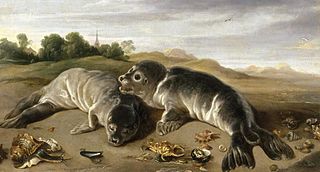
Paul de Vos was a Flemish Baroque painter who specialized in mainly in compositions of animals, hunting scenes and still lifes. He worked for an elite clientele and was a regular collaborator of leading Antwerp painters such as Anthony van Dyck and Peter Paul Rubens.

Sir Peter Paul Rubens was a Flemish artist and diplomat from the Duchy of Brabant in the Southern Netherlands. He is considered the most influential artist of the Flemish Baroque tradition. Rubens's highly charged compositions reference erudite aspects of classical and Christian history. His unique and immensely popular Baroque style emphasized movement, colour, and sensuality, which followed the immediate, dramatic artistic style promoted in the Counter-Reformation. Rubens was a painter producing altarpieces, portraits, landscapes, and history paintings of mythological and allegorical subjects. He was also a prolific designer of cartoons for the Flemish tapestry workshops and of frontispieces for the publishers in Antwerp.

Venus with a Mirror is a painting by Titian, now in the National Gallery of Art in Washington, DC, and it is considered to be one of the collection's highlights.
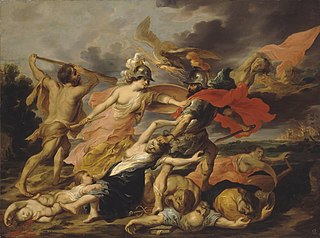
Victor Wolfvoet (II) or Victor Wolfvoet the Younger, was a Flemish art dealer and painter of history and allegorical paintings. His artistic output was heavily influenced by Peter Paul Rubens.

Hercules's Dog Discovers Purple Dye or The Discovery of Purple by Hercules's Dog is an oil painting by Flemish artist Peter Paul Rubens painted circa 1636, towards the end of his career. It depicts the mythical discovery of Tyrian purple by Hercules and his dog, and was one of dozens of oil on panel sketches made by Rubens for the decoration of the Torre de la Parada in Spain. A completed painting based on Rubens's sketch was made by Theodoor van Thulden in 1636-8, and is now held by the Prado Museum.
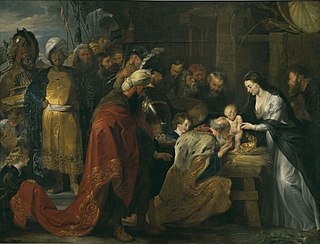
The Adoration of the Magi is a c.1617–18 painting by Peter Paul Rubens. It is now in the Musée des Beaux-Arts de Lyon

Descent from the Cross is an oil on panel painting of 1600–1602 by the Flemish artist Peter Paul Rubens. It was his first major commissional work made for the private chapel of Eleonora de’ Medici Gonzaga (1567–1611), duchess of Mantua. The painting remained somewhat obscure until 2005, when it was discovered by German art historian Justus Müller-Hofstede, a specialist on Rubens' early work.

Bacchanalia is a c.1615 oil painting of Bacchus, Silenus, bacchantes and satyrs by Peter Paul Rubens. Originally painted on panel, it was transferred to canvas by A. Sidorov in 1892.
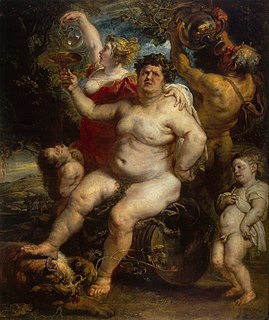
Bacchus is a 1638-1640 oil painting of Bacchus by Peter Paul Rubens, now in the Hermitage Museum, for which it was purchased in 1772. It was originally on a panel support but was transferred to canvas in 1891 by A. Sidorov. An autograph copy of the work is now in the Uffizi in Florence.

Roman Charity is an oil on canvas painting by Peter Paul Rubens, executed c. 1612, now in the Hermitage Museum, in Saint Petersburg, for which it was bought from Koblenz's collection in Brussels in 1768. In 1828 D. A. Smitha of the Hermitage misattributed it as a copy. Later researchers agreed in 1864 and the work was placed in store until 1905, when a re-examination restored its autograph status.

Ecce Homo or Christ Wearing the Crown of Thorns is a oil on oak panel painting of the [8Ecce Homo]] subject by Peter Paul Rubens, executed c. 1612, now in the Hermitage Museum, in Saint Petersburg. The Hermitage also houses an oil study for its figure of Pilate.
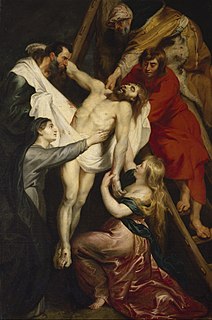
The Descent from the Cross is a c.1618 oil on canvas painting by Peter Paul Rubens and his studio. The broad free brushstrokes of the old man's body and robes point to Rubens' pupil Anthony van Dyck. It is now in the Hermitage Museum in St Petersburg.

Venus and Adonis is an oil on canvas painting by Peter Paul Rubens and his studio, executed c. 1614, now in the Hermitage Museum, in [8Saint Petersburg]]. It is a version of an autograph work from 1609 now in the Museum Kunstpalast in Düsseldorf, replacing its rocky background with Venus's attribute of a golden chariot. A third version was in the Kaiser-Friedrich-Museum in Berlin until being destroyed during World War Two.




















